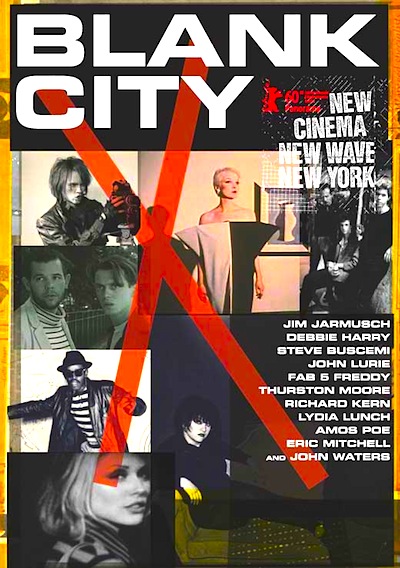By Joe Bendel. In 1968, Amos Poe was a budding photographer visiting family in Czechoslovakia. For obvious reasons, the Soviet invasion cut short his photographic sojourn to the countryside. There were no such constraints in the lawless anarchy of late 1970s New York, where Poe became a trailblazer in the underground Super-8 filmmaking community. Céline Danhier profiles those squatter-auteurs in Blank City, which opens this Wednesday in New York at the IFC Center.
Abe Beam’s New York was about as pre-Giuliani as the City ever got. The rule of law was tenuous at best, but rents in the East Village were relatively affordable—not that anyone even bothered to pay. CBGB’s was the center of the musical universe, also hosting a number of early screenings of what would later be dubbed the “No Wave” movement.
 Danhier scored interviews with just about every significant surviving figure on the scene at the time. A portrait emerges of a kind of dormitory-like atmosphere, where everyone knew each other, but nobody had a job. Though they do not confess it outright, “coolness” within the clique was clearly of primary importance. Musician-turned-filmmaker John Lurie admits he hid his saxophone, “because nobody was doing what they knew how to do . . . technique was so hated.”
Danhier scored interviews with just about every significant surviving figure on the scene at the time. A portrait emerges of a kind of dormitory-like atmosphere, where everyone knew each other, but nobody had a job. Though they do not confess it outright, “coolness” within the clique was clearly of primary importance. Musician-turned-filmmaker John Lurie admits he hid his saxophone, “because nobody was doing what they knew how to do . . . technique was so hated.”
The great irony of Blank is that Danhier’s doc is far easier to watch than a good many of the films it documents. Fortunately, just about every chaotic shoot generated its share of humorous anecdotes, which generously pepper Blank. Indeed, the film is at its best when filmmakers like Jim Jarmusch reminisce about their early days. However, it is hard to stifle the eye-rolling when her interview subjects get political. At least Lizzie Borden expresses grief for the World Trade Center terrorist attack, while acknowledging the awkward similarity between 9/11 and the conclusion of her film Born in Flame.
Granted, Poe’s Blank Generation is probably not at the top of a lot of Netflix queues. Still, it is bit of an eye-opener to see how many figures from the Blank scene either legitimately crossed over, like Jarmusch, Steve Buscemi, Debbie Harry, Susan Seidelman, and Ann Magnuson, or kind-of sort-of did, such as John Lurie, Charlie “Wild Style” Ahearn, and Bette Gordon.
Like the films under discussion, Blank is best when its participants do not take their illustrious careers too seriously. While the time spent with the subsequent “Cinema of Transgression” lacks the same charm, the film mostly works as a valentine to scruffy independent filmmaking. Surprisingly entertaining, Blank opens today at the IFC Center.
Posted on February 6th, 2011 at 3:24pm.